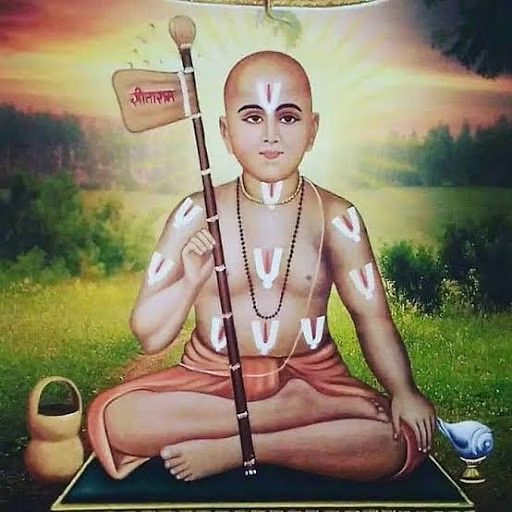RAMANANDA (1300-1410?), promoter of Vaishnav Bhakti in North India and founder of the Bairagi sect of anchorites, was born at Prayaga (Allahabad) in a Kanyakubja Brahman family. He studied in Kasi (Banaras), the ancient seat of learning, and it was here that he became a disciple of Raghavananda, the fourth dacharya (teacher, preacher, head of a sect) in the line of Ramanuja, the founder of Vishishtadvaita. He was, however, more liberal than his guru with regard to the caste system in general and untouchability in particular. He initiated a separate sect of his own, the Ramavat or Ramanandi Sampradaya, with Lord Rama and Sita as its Supreme Deity instead of Chaturbhuja Narayana and Lakshmi worshipped by followers of Sri Sampradaya.
Ramananda established himself as a teacher at Kasi, where to this day Parichgariga Ghat is associated with his name. From there his disciples, the Ramanandi Bairagis, spread his message of Rama worship all over the country, but mostly in the central Gangetic plain. It is perhaps his liberal views regarding caste distinctions that have led to a well-established tradition that a number of lower-caste saints of the Bhakti movement, such as the weaver Kabir, leather worker Ravidas, the barber Sain, and the Jat peasant Dhanna were his disciples, chronological impossibilities notwithstanding. Many works in Sanskrit and Hindi are ascribed to Ramananda by his followers, but modern scholars accept only two, Vaishnavamatabja Bhaskar and Ramachand Paddhati as authentic.
Two Hindi padas (hymns) attributed to him are found in the Sarbangi compiled by Rajjab. One of them, which duplicates his single hymn included in Sikh Scripture, the Guru Granth Sahib, points to his nearness to the Sant tradition of nirgunabhakti (worship of the Transcendent One). In this hymn (GG, 1195) idol worship is clearly rejected; the supreme Deity, Brahman, is conceived as all-pervading, revealed to the mind only through the sabda of the True Guru, whereas Vedas and Puranas avail nothing.
References:
- Macauliffe, Max Arthur, The Sikh Religion. Oxford, 1909
- Nabhadas, Bhaktamala, ed. S.B. Prasad. Lucknow, 1951
- Barathwal, P.O., Ramananda ki Hindi Rachnayein. Varanasi, 1955
Ramananda
- Saint Ramananda, who was born into a Brahman Family, spent the majority of his life in the holy city of Varanasi.
- His birth and death dates are unknown, but historical evidence suggests he was one of the early saints and a pioneering member of the Bhakti movement as it rapidly flourished in North India between the 14th and mid-15th centuries, during the Islamic rule period.
- Tradition holds that Saint Ramananda was motivated by the south Indian Vedanta scholar Ramanuja while developing his philosophy and devotional themes, but evidence also reveals that Saint Ramananda was influenced by Nathpanthi ascetics of the Yoga school of Hindu philosophy.
- He was a prominent Rama worshipper and the founder of the Bhakti movement in northern India. He was a social reformer who opened the door to Bhaktism to everybody without regard for birth, caste, creed, or gender.
- He wrote and discussed his teachings in Hindi, making religion more accessible to the general public.
- His lyrics are also mentioned in the Adi Granth. He was the Guru of several poet-saints.
- His Disciples are
- Kabir, a Muslim weaver
- Ravidas, a cobbler
- Sena, a barber
- Dhanna, a Jat peasant
- Sadhana, a butcher
- Narahari, a goldsmith; and
- Pipa, a Rajput prince
- Ramananda has been referred to as “the bridge between the Bhakti movement of the South and the Bhakti movement of the North.”
- Sant-parampara (literally, the tradition of bhakti saints) in north India is often credited to Saint Ramananda.



